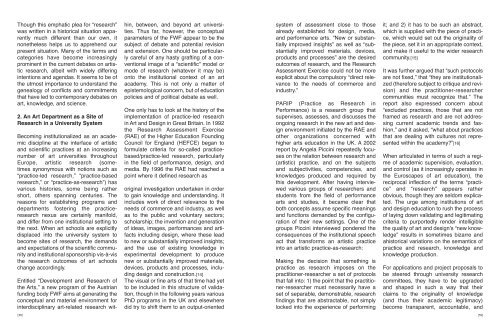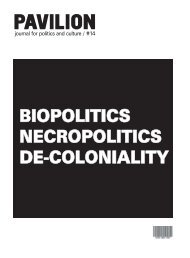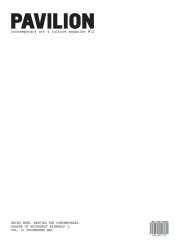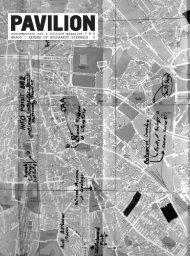Download pdf version of issue no. 16 (4 Mb) - Pavilion
Download pdf version of issue no. 16 (4 Mb) - Pavilion
Download pdf version of issue no. 16 (4 Mb) - Pavilion
Create successful ePaper yourself
Turn your PDF publications into a flip-book with our unique Google optimized e-Paper software.
Though this emphatic plea for “research”<br />
was written in a historical situation apparently<br />
much different than our own, it<br />
<strong>no</strong>netheless helps us to apprehend our<br />
present situation. Many <strong>of</strong> the terms and<br />
categories have become increasingly<br />
prominent in the current debates on artistic<br />
research, albeit with widely differing<br />
intentions and agendas. It seems to be <strong>of</strong><br />
the utmost importance to understand the<br />
genealogy <strong>of</strong> conflicts and commitments<br />
that have led to contemporary debates on<br />
art, k<strong>no</strong>wledge, and science.<br />
2. An Art Department as a Site <strong>of</strong><br />
Research in a University System<br />
Becoming institutionalized as an academic<br />
discipline at the interface <strong>of</strong> artistic<br />
and scientific practices at an increasing<br />
number <strong>of</strong> art universities throughout<br />
Europe, artistic research (sometimes<br />
sy<strong>no</strong>nymous with <strong>no</strong>tions such as<br />
“practice-led research,” “practice-based<br />
research,” or “practice-as-research”) has<br />
various histories, some being rather<br />
short, others spanning centuries. The<br />
reasons for establishing programs and<br />
departments fostering the practiceresearch<br />
nexus are certainly manifold,<br />
and differ from one institutional setting to<br />
the next. When art schools are explicitly<br />
displaced into the university system to<br />
become sites <strong>of</strong> research, the demands<br />
and expectations <strong>of</strong> the scientific community<br />
and institutional sponsorship vis-à-vis<br />
the research outcomes <strong>of</strong> art schools<br />
change accordingly.<br />
Entitled “Development and Research <strong>of</strong><br />
the Arts,” a new program <strong>of</strong> the Austrian<br />
funding body FWF aims at generating the<br />
conceptual and material environment for<br />
interdisciplinary art-related research wit-<br />
[58]<br />
hin, between, and beyond art universities.<br />
Thus far, however, the conceptual<br />
parameters <strong>of</strong> the FWF appear to be the<br />
subject <strong>of</strong> debate and potential revision<br />
and extension. One should be particularly<br />
careful <strong>of</strong> any hasty grafting <strong>of</strong> a conventional<br />
image <strong>of</strong> a “scientific” model or<br />
mode <strong>of</strong> research (whatever it may be)<br />
onto the institutional context <strong>of</strong> an art<br />
academy. This is <strong>no</strong>t only a matter <strong>of</strong><br />
epistemological concern, but <strong>of</strong> education<br />
policies and <strong>of</strong> political debate as well.<br />
One only has to look at the history <strong>of</strong> the<br />
implementation <strong>of</strong> practice-led research<br />
in Art and Design in Great Britain. In 1992<br />
the Research Assessment Exercise<br />
(RAE) <strong>of</strong> the Higher Education Founding<br />
Council for England (HEFCE) began to<br />
formulate criteria for so-called practicebased/practice-led<br />
research, particularly<br />
in the field <strong>of</strong> performance, design, and<br />
media. By 1996 the RAE had reached a<br />
point where it defined research as<br />
original investigation undertaken in order<br />
to gain k<strong>no</strong>wledge and understanding. It<br />
includes work <strong>of</strong> direct relevance to the<br />
needs <strong>of</strong> commerce and industry, as well<br />
as to the public and voluntary sectors;<br />
scholarship; the invention and generation<br />
<strong>of</strong> ideas, images, performances and artifacts<br />
including design, where these lead<br />
to new or substantially improved insights;<br />
and the use <strong>of</strong> existing k<strong>no</strong>wledge in<br />
experimental development to produce<br />
new or substantially improved materials,<br />
devices, products and processes, including<br />
design and construction.[14]<br />
The visual or fine arts <strong>of</strong> that time had yet<br />
to be included in this structure <strong>of</strong> validation,<br />
though in the following years various<br />
PhD programs in the UK and elsewhere<br />
did try to shift them to an output-oriented<br />
system <strong>of</strong> assessment close to those<br />
already established for design, media,<br />
and performance arts. “New or substantially<br />
improved insights” as well as “substantially<br />
improved materials, devices,<br />
products and processes” are the desired<br />
outcomes <strong>of</strong> research, and the Research<br />
Assessment Exercise could <strong>no</strong>t be more<br />
explicit about the compulsory “direct relevance<br />
to the needs <strong>of</strong> commerce and<br />
industry.”<br />
PARIP (Practice as Research in<br />
Performance) is a research group that<br />
supervises, assesses, and discusses the<br />
ongoing research in the new art and design<br />
environment initiated by the RAE and<br />
other organizations concerned with<br />
higher arts education in the UK. A 2002<br />
report by Angela Piccini repeatedly focuses<br />
on the relation between research and<br />
(artistic) practice, and on the subjects<br />
and subjectivities, competencies, and<br />
k<strong>no</strong>wledges produced and required by<br />
this development. After having interviewed<br />
various groups <strong>of</strong> researchers and<br />
students from the field <strong>of</strong> performance<br />
arts and studies, it became clear that<br />
both concepts assume specific meanings<br />
and functions demanded by the configuration<br />
<strong>of</strong> their new settings. One <strong>of</strong> the<br />
groups Piccini interviewed pondered the<br />
consequences <strong>of</strong> the institutional speech<br />
act that transforms an artistic practice<br />
into an artistic practice-as-research:<br />
Making the decision that something is<br />
practice as research imposes on the<br />
practitioner-researcher a set <strong>of</strong> protocols<br />
that fall into: 1) the point that the practitioner-researcher<br />
must necessarily have a<br />
set <strong>of</strong> separable, demonstrable, research<br />
findings that are abstractable, <strong>no</strong>t simply<br />
locked into the experience <strong>of</strong> performing<br />
it; and 2) it has to be such an abstract,<br />
which is supplied with the piece <strong>of</strong> practice,<br />
which would set out the originality <strong>of</strong><br />
the piece, set it in an appropriate context,<br />
and make it useful to the wider research<br />
community.[15]<br />
It was further argued that “such protocols<br />
are <strong>no</strong>t fixed,” that “they are institutionalized<br />
(therefore subject to critique and revision)<br />
and the practitioner-researcher<br />
communities must recognize that.” The<br />
report also expressed concern about<br />
“excluded practices, those that are <strong>no</strong>t<br />
framed as research and are <strong>no</strong>t addressing<br />
current academic trends and fashion,”<br />
and it asked, “what about practices<br />
that are dealing with cultures <strong>no</strong>t represented<br />
within the academy?”[<strong>16</strong>]<br />
When articulated in terms <strong>of</strong> such a regime<br />
<strong>of</strong> academic supervision, evaluation,<br />
and control (as it increasingly operates in<br />
the Euroscapes <strong>of</strong> art education), the<br />
reciprocal inflection <strong>of</strong> the terms “practice”<br />
and “research” appears rather<br />
obvious, though they are seldom explicated.<br />
The urge among institutions <strong>of</strong> art<br />
and design education to rush the process<br />
<strong>of</strong> laying down validating and legitimating<br />
criteria to purportedly render intelligible<br />
the quality <strong>of</strong> art and design’s “new k<strong>no</strong>wledge”<br />
results in sometimes bizarre and<br />
ahistorical variations on the semantics <strong>of</strong><br />
practice and research, k<strong>no</strong>wledge and<br />
k<strong>no</strong>wledge production.<br />
For applications and project proposals to<br />
be steered through university research<br />
committees, they have to be upgraded<br />
and shaped in such a way that their<br />
claims to the originality <strong>of</strong> k<strong>no</strong>wledge<br />
(and thus their academic legitimacy)<br />
become transparent, accountable, and<br />
[59]








